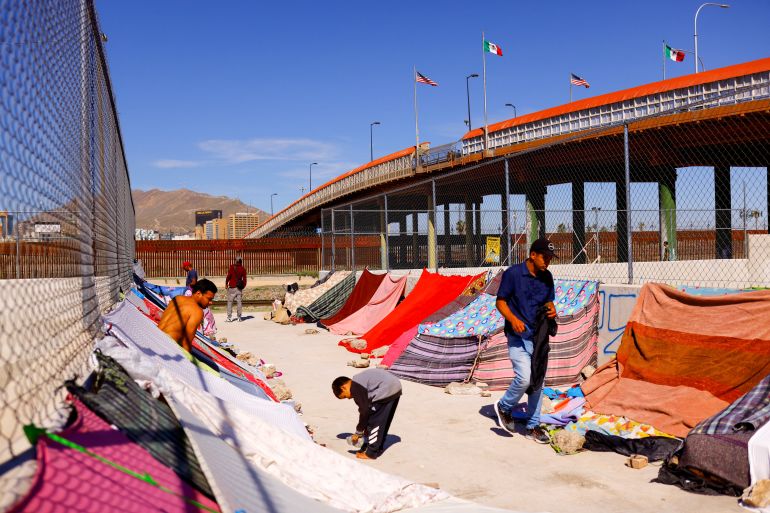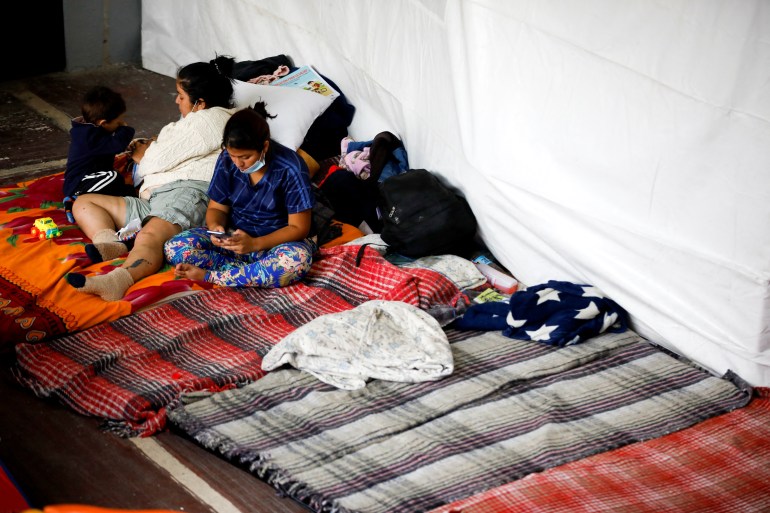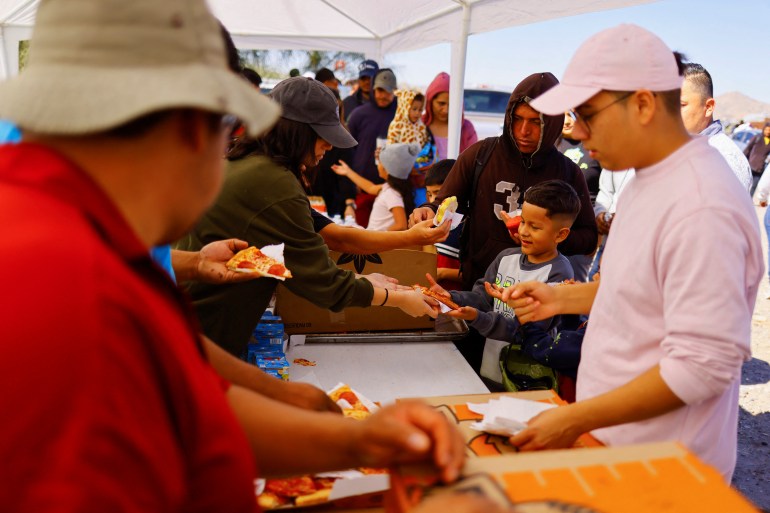New crisis brewing for Venezuelans turned back at US border
New deal allowing US to send Venezuelan asylum seekers back to Mexico at southern border sows confusion and frustration.

Mexico City — Dozens of migrants and asylum seekers sit on a cold and rainy street outside the offices of the National Commission for Refugee Assistance (COMAR). Most of them were deported from the United States to Mexico just a few days ago.
Almost everyone here is from Venezuela, and many are women with young children. Migrant and refugee shelters in the area are full, so they have been sleeping outside for the past few nights.
Keep reading
list of 3 itemsUS to take in some Venezuelans but will send most back to Mexico
US to begin accepting Venezuelan claims under new migration plan
Luis Conde, who at 43 is one of the older men in the group, says most of the people here crossed the border from Mexico into the US earlier this month and turned themselves in to immigration officials, expecting to begin the process of requesting asylum — like other Venezuelan asylum seekers have been doing in recent months.
Instead, they were detained by US border agents and returned to Mexico. Luis says the agents cited the policy known as “Title 42”, which enables US immigration authorities to expel migrants and asylum seekers to Mexico under the pretext of the COVID-19 pandemic.
“It’s worth mentioning that all of us here have been vaccinated,” says Luis, still wearing the blue sweatpants given to him by US border agents. “I really don’t understand the situation; we were told our immigration process was being finalised in Laredo [Texas], but that was not the case.”
Another Venezuelan emigre approaches me outside the refugee assistance offices. His name is Jonathan. He is tall and brawny. He says he was a professional bodyguard back in Venezuela and was hoping to find work in the US before he was deported to Mexico.
Jonathan tells me he was part of the first group of Venezuelan nationals sent to Mexico from the US under a new change in policy.
“Nobody understood what was going on,” says Jonathan, as he recalls the moments before US border agents sent him back to Mexico. “They put handcuffs on us, the kind that go from your hands to your feet.
“It wasn’t until we exited the aeroplane that we understood what was happening.”

Uncertainty widespread
There is a look of uncertainty and frustration on everyone’s face outside the COMAR office, as more migrants and asylum seekers continue to trickle into the area, all of them seeking guidance from Mexican authorities.
But even officials here seem confused about the constantly changing policies on the border.
The most recent shift involves an agreement between the US and Mexico under which the US has agreed to grant 24,000 humanitarian visas to Venezuelan asylum seekers.
But that excludes those entering the country by land — who are now being sent to Mexico. The change expanded the powers of Title 42 to carry out “fast track” deportations, specifically of Venezuelan nationals.
“These can’t even be called deportations,” says Eunice Rendon of Agenda Migrante, an NGO that promotes migrants’ rights in Mexico. “This deportation under Title 42 is an expedited deportation. People aren’t given their due process; they’re simply detained and left on the border with Mexico without a chance to request asylum.”
There is another concern: Human rights advocates say the new restrictions announced by the Biden administration could harm the tens of thousands of underage migrants and asylum seekers who transit through Mexico en route to the US.
“That’s another thing that worries me about these transit visas,” says Rendon. “It’s been announced that unaccompanied minors are not candidates for these visas, despite the fact that unaccompanied minors have accounted for a significant part of the migration phenomenon since 2014. This includes Venezuelans.”
New crisis taking shape
There is a sense in Mexico that another migrant crisis has already begun.
The challenge government officials are faced with is complex. Not only has Mexico agreed to take in Venezuelans expelled from the US, but more migrants and asylum seekers continue to arrive from the country’s southern border every day.
“We need to work with the labour secretary, to give these people some kind of legal status,” says Rosa Maria Gonzalez, who leads the Migrant Affairs Committee in Mexico’s lower house of Congress. “We’re working on it, but I believe people are arriving faster than we can keep up with.”
Gonzalez has been one of the most critical voices in Mexico’s Congress over the constant shifts in policy toward migrants and asylum seekers.
“I think it’s time we say enough is enough,” she says. “I know we have a relationship with the United States to think of, but the topic of migration hasn’t been easy. The United States treats Mexico like a petty cash drawer. Everything they don’t want they send here.”
Experts in Mexico say one thing that could help alleviate the pressure on migrant shelters and refugee assistance organisations in the short term is for Title 42 to be removed altogether.
Even though US President Joe Biden promised the measure would be lifted, refugee rights advocates like Rendon say that far from seeking to eliminate Title 42, the policy has been embraced and misused by the Biden administration, further upending the traditional US asylum process.
“[Title 42] is an inhumane policy,” says Rendon. “It may have been installed by [Donald] Trump, but it has been utilised more by Biden. In other words, the one who has abused it the most is Biden’s government.”

Surge in arrivals
The perspective in Washington remains that something needs to be done to curb migrant and asylum-seeker arrivals at the border. So far this fiscal year, the number of “migrant encounters” on the US-Mexico border has exceeded 2 million, according to government data — a record high.
It could be that with the November midterm elections just around the corner, US Democrats don’t want to appear weak on immigration. But what may look like good politics for the Biden administration has resulted in a bad situation for migrants and asylum seekers. And it is only getting worse.
While Mexico and the United States have agreed to a shared commitment to addressing the Venezuelan migrant and refugee crisis, neither country appears prepared for what’s coming.
This month, the United Nations reported that since the start of the political and economic crisis in Venezuela in 2015, more than 7.1 million Venezuelans are living as refugees and migrants around the world.
As crisis conditions in the South American country persist, so does the exodus. Though the vast majority of Venezuelans are scattered across 11 countries in Latin America, an increasing number of them seem to consider the US their best chance at asylum.
And despite the constantly changing policies aimed at restricting migrant and refugee flows in the region, no measure by either country appears to be having a meaningful effect on the number of people moving northward to the US.